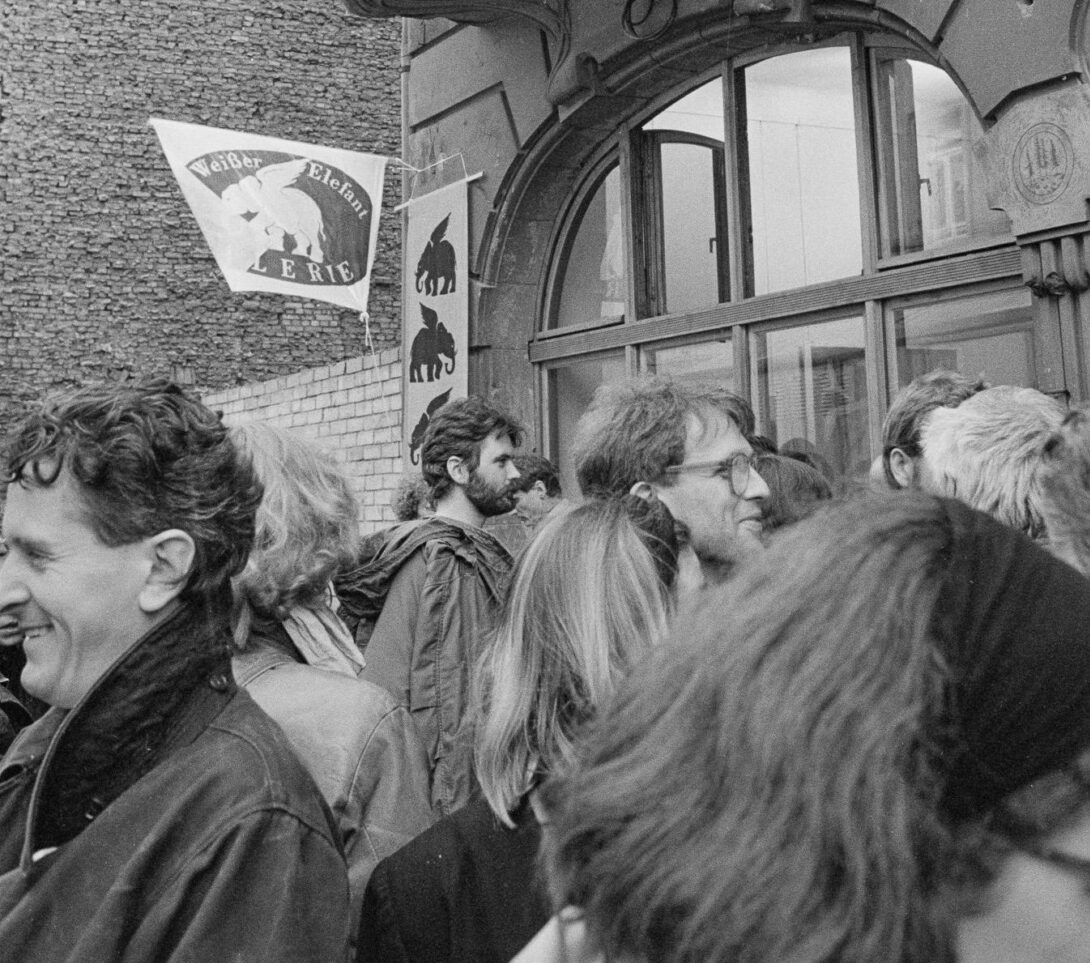Kunst Raum Mitte has a history of almost 40 years. It is one of the oldest municipal art institutions in Berlin’s network of galleries.
Founded in the GDR
In 1987, galerie weisser elefant was founded on Almstadtstraße in East Berlin as a state-funded municipal gallery. Its establishment marked a turning point in the art landscape of the GDR. Amid political and social upheaval, the gallery established itself as a platform for up-and-coming, independent artists. Notably, the actions and performances during the Permanent Art Conference in June 1989, shortly before the end of the GDR, marked a turning point and reflected the artistic awakening of the time.
The remaining historical material from galerie weisser elefant provides insights into the beginnings and development of the venue. These include exhibition photos, press articles, correspondence, administrative files, and ephemera. These documents reveal that the name ‘weisser elefant’ referred to a corner pub located on Almstadtstraße, the same street that housed the gallery. Two white elephant figures from a Berlin liqueur manufacturer were displayed in its windows, earning it the informal name ‘Zum Weißen Elefanten’ (see Klaus Bädicker: Vorstadtsalat — eine Bild-Text-Collage über die Spandauer und ein wenig die Rosenthaler Vorstadt in Berlins Mitte im letzten DDR-Jahrzehnt, Berlin 2002). This pub was an anchor point in the former Scheunenviertel and the only one on the street to have survived after 1945. The name of the gallery was intended to evoke the history of the district while also presenting the white elephant, a kind of heraldic animal, as a humorous and timeless symbol. This is confirmed by a document by Gabi Ivan, who co-directed the gallery with Ralf Bartholomäus at the time of its founding.
After the fall of the wall, the gallery opened up to new art forms, such as performances and installations, which had previously been unthinkable in the GDR. These were curated by Christoph Tannert and Eugen Blume, among others, showing works by artists such as Via Lewandowsky, Durs Grünbein, and Karla Sachse. The gallery supported up-and-coming talents such as Carsten and Olaf Nicolai and Annelies Strba, who later went on to achieve international success. In addition, the collaboration with the GDR underground led to the first exhibition of the brothers Robert and Ronald Lippock from Ornament & Verbrechen and the release of their LP to rococo rot, from which an internationally renowned music project emerged. The gallery became a place where young artists could explore their practice without the pressure of the art market.
Relocation to Auguststraße
As an institution under the Office for Architecture-Related Art of the East Berlin Magistrate, galerie weisser elefant was also impacted by the decision to liquidate the office in the fall of 1990.
In 1998, galerie weisser elefant moved to Auguststraße 21, initially to the basement of the former Nikolai Ostrowski Secondary School for the Visually Impaired, as it was known in the GDR. Since 2000, the gallery has been housed in the school’s former director’s house at Auguststraße 21. Surrounded by galleries with a commercial orientation, galerie weisser elefant remained true to its mission of serving as a communal space for promoting young artists and providing a platform for unconventional exhibition formats and forms of expression.
The former school building served for many years as a cultural center, hosting different practitioners in the arts and culture scene. From 1998 to 2002, for example, the Department of Culture made rooms available free of charge to the Renate Comic Library. The library is now located just a short distance away in Tucholskystraße.
Today, the gallery shares the building with the Farbklang studio of the MiK – Jugendkunstschule Berlin-Mitte and the Fanny Hensel Music School.
Renaming to Kunst Raum Mitte
The new name, Kunst Raum Mitte, is intended to signal a reorientation of the municipal gallery while acknowledging and continuing its history. In its inaugural annual program, Kunst Raum Mitte directly addresses the gallery’s eventful history and aims to rethink what a municipal gallery was before, is today, and should be in the future: a space open for exchange and discourse with the public and a constantly changing urban society.
The gallery is currently undergoing further upheaval and a transformation of its profile. Its renaming to Kunst Raum Mitte, initiated by the Department of Art, Culture and History, is a key part of this process. It intends to link the gallery’s history and concept of contemporary discourse with the art of a subsequent generation and current debates surrounding a pluralistic and diverse urban society.
In 2024, the Department of Art, Culture and History appointed a new management team through a selection process overseen by a selection committee and a jury of experts. With the guidance of curators Natalie Keppler and Agnieszka Roguski, the municipal gallery is ready to take on these challenges.
Click here to visit galerie weisser elefant’s page:




